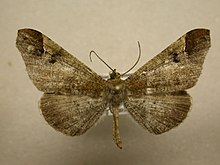丝角蝶科
| 丝角蝶科 | |
|---|---|

| |
| Macrosoma bahiata | |
| 科学分类 | |
| 界: | 动物界 Animalia |
| 门: | 节肢动物门 Arthropoda |
| 纲: | 昆虫纲 Insecta |
| 目: | 鳞翅目 Lepidoptera |
| 亚目: | 有喙亚目 Glossata |
| 演化支: | 腔鳞类 Coelolepida |
| 演化支: | 肌旋喙类 Myoglossata |
| 演化支: | 新鳞翅类 Neolepidoptera |
| 下目: | 异脉下目 Heteroneura |
| 演化支: | 真鳞翅类 Eulepidoptera |
| 演化支: | 真异脉类 Euheteroneura |
| 演化支: | 双孔类 Ditrysia |
| 派: | 木蠹蛾派 Cossina |
| 亚派: | 蚕蛾亚派 Bombycina |
| 总科: | 丝角蝶总科 Hedyloiea |
| 科: | 丝角蝶科 Hedylidae Guenée, 1857, nec. Bergh, 1895 |
| 模式种 | |
| Macrosoma tipulata Hübner, 1818 | |
| 属 | |
|
丝角蝶属 Macrosoma Hübner, 1818 | |
| 多样性 | |
| 35 个被承认的物种 | |
丝角蝶科 (学名:Hedylidae),又名喜蝶科,是一类昆虫,分类学上属于鳞翅目凤蝶总科下的一科。曾属于蛾类,当时被视为凤蝶总科的一个姐妹群。1986年,斯考伯根据当时的研究结论,合并了原有的所有属为单一的丝角蝶属(Macrosoma ),并从蛾类划到蝶类,设立单一的丝角蝶总科(Hedyloidea),但目前已合并至凤蝶总科。本科目前已发现的全部35个受承认的物种,均位于新热带界。[1]
分类学与系统发生学
[编辑]本科曾被分类为尺蛾科Oenochrominae亚科下的一个族[2],称为丝角蛾族(Hedylicae),Prout LB[1]认为该族应当被视为一科。斯考伯首先提出了该科实际上是一种未被承认的蝴蝶的假说,同时认为其应当是“真正的蝴蝶”(即当时的“凤蝶总科”,包括凤蝶科,粉蝶科,灰蝶科,蛱蝶科,不包括弄蝶科)的姐妹群,因此单列一总科,称丝角蝶总科(Hedyloidea)。韦恩特劳伯和米勒就斯考伯的这一假说展开了一些争论[3]。韦勒· S·J 和 帕斯雷· D·P 在1995年发布了支持斯考伯观点的分子生物学研究[4]。2005年的一项更全面的研究,基于 57 个样本类群、3 个基因和 99 个形态特征的数据,恢复了曾被取消的丝角蝶属,并设立丝角蝶总科,作为凤蝶总科和弄蝶总科共同的姐妹群[5]。蝴蝶下目的三大总科现已合并为单一的凤蝶总科。2015年的系统发生学研究显示,丝角蝶科应当作为凤蝶总科(这里包括弄蝶科)的基群,与双孔次目螟蛾类中的蛾的关系比其他蝴蝶与这些蛾的关系更亲密[6][7][8]。
由于假说中的若干个物种群落之间不存在明显差异,加上基本的形态学研究,斯考伯在1986年合并了原有的五个属为单一的丝角蝶属。但是,丝角蝶属的系统发生学仍有待进一步研究。
学名说明
[编辑]在动物界当中,存在着许多分类层级的学名与丝角蝶属的学名Macrosoma 拼写相同或者是同音词[9]。例如:Macrosoma Leach 1819(爬行动物),Macrosoma de Haan 1826(蜻蛉目),Macrosoma Robineau-Desvoidy 1830(Macrosoma multisulcata Berlese 1913) ,双翅目蝇科,Macrosoma Brandt 1835(腔肠动物),Macrosoma Hope 1837(鞘翅目),Macrosoma Lioy 1864 或 1865(双翅目麻蝇科),Macrosoma Hammer 1979[10](M.rugosa; Acarina:Oribatidae)。
另有两个Hedyle Guenée加剧了命名混乱的状况,那就是Hedyle Guenée, 1857和Hedyle Bergh, 1895(Opisthobranchia 目Acochlidioidea 总科Hedylopsidae (Odhner, 1952)科的海牛[11],目前被归类于 Hedylopsis Thiele,1931[12]。另有Hedyle Malmgren 1865(属于多毛纲)[13]。因此,Hedylidae Bergh,1895及其模式种 Hedyle weberi Bergh,1895)也是无效的命名。
物种列表
[编辑]以下分类主要依照形态学进行。
DNA 序列
[编辑]本科的部分物种(例如Macrosoma semiermis等)接受了DNA测序,被测定的基因包括线粒体基因中的 “细胞色素氧化酶 I”、“ND1”,细胞核基因中的 “无翅基因”、“Ef-1?”[14]等。部分物种目前正在接受条形码检测。[15]
外部链接
[编辑]- Caterpillars, pupae, butterflies & moths of the ACG [Accessed March 2007]
- Hearing(页面存档备份,存于互联网档案馆) [Accessed March 2007]
- Ears(页面存档备份,存于互联网档案馆) [Accessed March 2007]
- Kendall 1976 pdf[永久失效链接] [Accessed March 2007]
- Lepindex [Accessed March 2007]
- Moths of Belize(页面存档备份,存于互联网档案馆) [Accessed March 2007]
- Unknown white hedylid from Nicaragua(页面存档备份,存于互联网档案馆) [Accessed March 2007]
- Hedylidae of Guyana(页面存档备份,存于互联网档案馆) [Accessed March 2007]
- Moths of Jamaica(页面存档备份,存于互联网档案馆) [Accessed March 2007]
- Barcoding progress and images [Accessed March 2007]
- Leptree sequencing progress [Accessed March 2007]
- Larva of unidentified species 79-SRNP-362c[永久失效链接] [Accessed March 2007]
- Larva of unidentified species 03-SRNP-21689[永久失效链接] [Accessed March 2007]
- Nicaraguan hostplants of Macrosoma semiermis [Accessed March 2007]
参考资料
[编辑]- Scoble, M.J. (1986). The structure and affinities of the Hedyloidea: a new concept of the butterflies. Bulletin of the British Museum (Natural History), Entomology Series, 53: 251-286.
- ^ 1.0 1.1 Scoble MJ. The structure and affinities of the Hedyloidea: a new concept of the butterflies. Bull. Brit. Mus. (nat. Hist.) (Ent.). 1986, 53: 251–286.
- ^ Scoble MJ. The structure and affinities of the Hedyloidea: a new concept of the butterflies. Bull. Brit. Mus. (nat. Hist.) (Ent.). 1986, 53: 251–286.
- ^ Weintraub JD, Miller JS. The structure and affinities of the Hedyloidea: a new concept of butterflies. Cladistics. 1987, 3 (3): 299–304. doi:10.1111/j.1096-0031.1987.tb00512.x.
- ^ Weller SJ, Pashley DP. In search of butterfly origins. Molecular Phylogenetics and Evolution. September 1995, 4 (3): 235–46. PMID 8845961. doi:10.1006/mpev.1995.1022.
- ^ Wahlberg N, Braby MF, Brower AV, et al. Synergistic effects of combining morphological and molecular data in resolving the phylogeny of butterflies and skippers. Proceedings of the Royal Society B. August 2005, 272 (1572): 1577–86. PMC 1560179
 . PMID 16048773. doi:10.1098/rspb.2005.3124.
. PMID 16048773. doi:10.1098/rspb.2005.3124.
- ^ Heikkilä, Maria; Mutanen, Marko; Wahlberg, Niklas; Sihvonen, Pasi; Kaila, Lauri. Elusive ditrysian phylogeny: An account of combining systematized morphology with molecular data (Lepidoptera). BMC Evolutionary Biology. 2015, 15. doi:10.1186/s12862-015-0520-0.
- ^ Heikkila, M.; Kaila, L.; Mutanen, M.; Pena, C.; Wahlberg, N. Cretaceous origin and repeated tertiary diversification of the redefined butterflies. Proceedings of the Royal Society B: Biological Sciences. 2011, 279 (1731): 1093. doi:10.1098/rspb.2011.1430.
- ^ Kawahara, A. Y.; Breinholt, J. W. Phylogenomics provides strong evidence for relationships of butterflies and moths. Proceedings of the Royal Society B: Biological Sciences. 2014, 281 (1788): 20140970. doi:10.1098/rspb.2014.0970.
- ^ Synonymy. [2017-11-27]. (原始内容存档于2011-07-20).
- ^ Hammer, M. (1979). Investigations on the oribatid fauna of Java. K. Dan. Vidensk. Selsk. Biol. Skr., 22(9): 34.
- ^ 存档副本. [2017-11-27]. (原始内容存档于2016-03-03).
- ^ 存档副本. [2007-04-15]. (原始内容存档于2007-03-31).
- ^ 存档副本. [2017-11-27]. (原始内容存档于2007-10-07).
- ^ Nucleotide sequences. [2017-12-07]. (原始内容存档于2001-07-14).
- ^ DNA Barcodes for Macrosoma. [2017-12-07]. (原始内容存档于2008-02-27).
